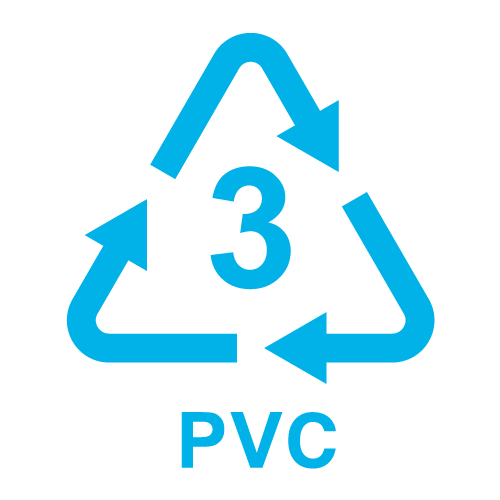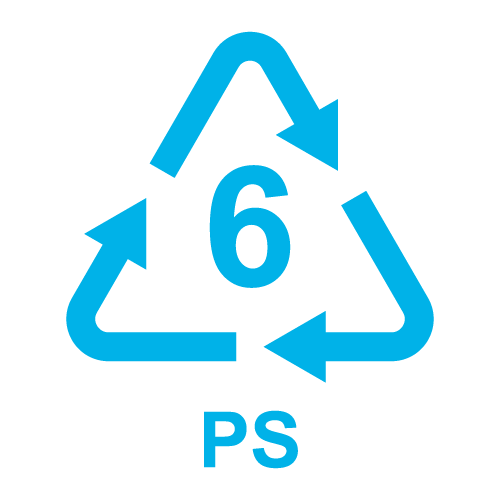Types of Plastic: 7 Plastic Symbols You See Daily (and why HDPE is our favorite)
Plastic isn’t all the same. There are actually hundreds of types of plastic, or polymers, each with different purposes, functions, properties, and colors. Even so, we only encounter a few types in our day-to-day lives.
The next time you do laundry, pour milk over your cereal, or drink bottled water, take a close look at the packaging. You’ll likely find a small triangle of arrows ringed around a numeral from 1 to 7. This symbol, known as a resin code, designates the type of plastic used in the bottle :
#1: Polyethylene Terephthalate, also known as PET or PETE, is one of the most commonly used plastics. It is used for food packaging (usually in the form of water or soda bottles) and in polyester fabrics and rope. PET can be recycled.
#2: High-Density Polyethylene, or HDPE, is classified into three types: High-Density, Low-Density, and Linear Low-Density. Collectively, these three types of plastic make the most common plastic in the world. We’re particularly interested in High-Density HDPE, which is resistant to moisture and chemicals and is ideal for detergent bottles, milk cartons, and…PVpallet’s solar panel pallets (more on that and HDPE later). HDPE can be recycled.
#3: Polyvinyl Chloride, usually called PVC, is resistant to bacteria, chemicals, weathering, and electric currents, which makes it useful in hospital settings, construction applications, and even tech. However, it’s also known as “the most dangerous plastic to human health” because it leaches dangerous toxins, such as BPA, lead, dioxins, mercury, and cadmium throughout its lifetime. PVC cannot be recycled through normal collections.
#4: Low-Density Polyethylene, or LDPE, is softer and more flexible version of HDPE. It is often used to line beverage cups and in grocery bags. LDPE can be recycled, but not in normal collections.
#5: Polypropylene (PP) is a very durable type of plastic—more heat resistant than some other types. Food packaging and storage meant for hot items is commonly made from PP. Because it can bend and retain its strength, it is also commonly used for straws, packaging tape, and prescription bottles. PP can be recycled (but usually isn’t).
#6: Polystyrene, known as PS or Styrofoam, is a low cost, rigid plastic that acts as a great insulator and is used often for coolers, takeout food containers, product packaging, and building insulation. Take care, though—Polystyrene is also known as a dangerous plastic because it leaches styrene, a neurotoxin, which is easily absorbed into food (and then ingested by humans). Polystyrene cannot be recycled.
#7: Other. This is the catch-all category for types of plastic that don’t belong in the other six categories or are combinations of the other types. You might see a #7 resin code on electronics, clear plastic cutlery, or even eyeglasses. Some of these plastics can be recycled under certain conditions but usually aren’t.
So many different plastics with so many different uses, compositions, productions and distributions means one thing: post-use plastic management is extremely complex.
In turn, that complexity translates into a waste problem—most post-consumer plastic ends up in landfills (we’ll get to that), but a lot of it becomes ocean pollution. In fact, over 8 million tons of plastic waste enters Earth’s oceans each year, leading some scientists to predict that by the year 2050, plastic in the ocean will actually outnumber the fish.
Over 8 million tons of plastic waste enters Earth’s oceans each year.
Some scientists predict that plastic will outnumber the fish by 2050.
According to EPA estimates, the US produced 27 million tons of plastic waste in 2018. Containers and packaging accounted for over half of that amount—14.5 million tons of this waste was made up of PET and HDPE plastics. No one knows for sure how long it takes these plastics to break down, but estimates range from 100 to 400 years to 500 years to 1000 years to…forever.
Theoretically, all plastics can be recycled. In practice, a variety of factors impact whether a given plastic can—or will—actually be recycled.
Some plastics, like LDPE plastic shopping bags, can technically be recycled but often aren’t because they tend to get tangled in expensive recycling machinery and endanger the entire process. Other times the color, smell, or cleanliness of certain plastics determines whether or not they will be recycled (or what they will be recycled into).
Often, however, if recycling isn’t financially beneficial, it won’t happen. In fact, out of the 27 million tons of plastic waste recorded by the EPA in 2018, only 3 million tons, or 8.7 percent, were recycled.
And the rest of it? Oceans and landfills.
Here’s the problem. Recycling needs to be two things: popular and profitable. If market demand for recycled goods doesn’t exist, or if the recycled goods themselves aren’t financially viable, potentially recyclable plastic will be relegated to landfills.
That’s where we come in.
Recycling needs to be two things: popular and profitable.
That’s where we come in.
Not only are PVpallet’s solar panel pallets adjustable, collapsible, stackable, and recyclable, they are made from High-Density HDPE plastic. HDPE’s long, virtually unbranched polymer chains make it one of the toughest plastics around. Plus, it’s one of the easiest plastics to recycle.
If you know anything about us, you know that our reusable pallets and bulk bins already prevent wood waste and deforestation, reduce the solar industry’s carbon footprint, and promote a circular economy. To us, it just makes sense to use post-consumer HDPE plastics in our reusable, recyclable solar PV module pallet system. Not only does every MW installation using PVpallets prevent 2 tons of wood waste—it also takes 80,000 milk jugs out of landfills.
If so much plastic has to exist, we’d rather see it protecting and shipping valuable solar modules than junking up the ocean.
Like this article? Check out our Reusable Packaging Blog and Resource Library.











